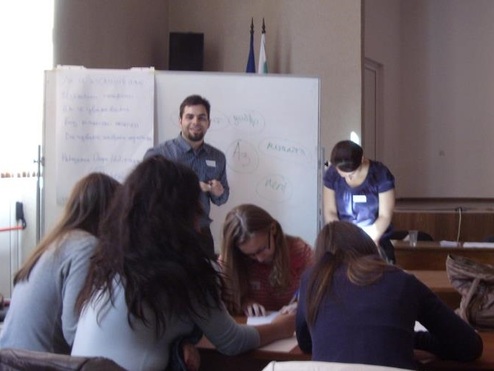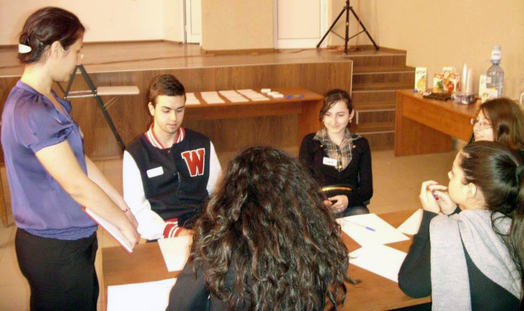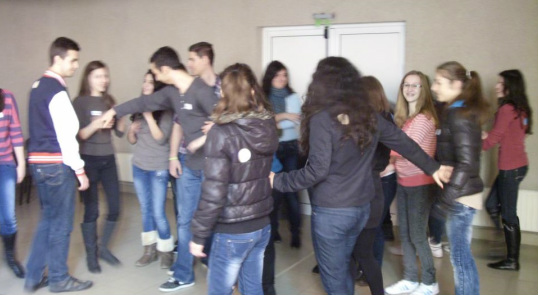Last week I was back again at the orientation for Fulbright English Teaching Assistants. I am a former ETA (2010-2012) and presented one of the topics last year at the same orientation, which was two days long. This year, however, the program has changed; it is longer, more detailed and designed to provide a more comprehensive preparation for the new teachers. Working closely with other English teachers as well as the Department for English and American Studies at Sofia University, I helped carry out a five-day training for the majority of the 28 American Fulbright Fellows who will be teaching in Foreign Language Schools across the country for the next ten months. My sessions included lesson planning, online resources, classroom management, teaching multilevel students and cultural adjustment. I also presented information about some of the extracurricular activities and projects some ETAs have become involved with in the past, including my own (Learning Through Our Differences).
When Iliana at the Fulbright Commission emailed me to invite me as a lecturer at the ETA orientation this year, I was more than thrilled. I've had the pleasure to meet more than 70 American Fulbrighters in Bulgaria during the time I've lived here; I've also met many Bulgarian alumni who have studied in the United States and have since returned home. All of them have very different backgrounds, lifestyles, beliefs and interests but the one thing they do have in common is the desire to build bridges across nations, mountains and oceans, or perhaps more importantly, between people. As U.S. Ambassador Ries said in her welcoming remarks to the new grantees, the core of the Fulbright program is people-to-people diplomacy. I am proud to be a part of the Fulbright legacy in Bulgaria and a continuing supporter of the activities carried out by the Commission.
Now that I have had some more time and experience between my former role as an ETA and my current one as an elementary school teacher, it was easier for me to reflect on the early days of my teaching career. Three years ago I really had no clue what I was getting myself into; the first day of classes I just sort of showed up at school and hoped for the best because I had no idea how or what to prepare. Eventually I settled into a routine (at least until the second semester) and figured out what worked best in each of my classes. But in hindsight there are many things I would have done differently had I had the experience and knowledge I have now. I don't think that any experiences we have can be labeled as bad, really, because we always learn something from them. And it was through reading about (and observing) good teaching practices that I realized just how many mistakes I made that I didn't even know I was making at the time. I have just a few quick tips, most of which are based off some mistakes I definitely made, and a couple of which I continuously need to work on:
1. Don't sweat the small stuff. When an unexpected problem arises, find a way to diffuse the situation or simply move on. It's not worth it to over-dramatize trivial things, like a broken printer or last-minute schedule change.
2. Be an enthusiastic leader for your students. Accept the responsibilities of being a role model with grace, and listen to their needs. Give them whatever support you can to help them achieve their learning goals.
3. Be over-prepared. That means planning for lessons to take less time than you think they will, and having a back-up lesson or activity in place. Plan for technology to fail. This will happen, but you don't have to let it ruin your day.
4. Spend more time in Bulgaria. Yes, the opportunities for traveling abroad are enticing, and this may be your first time living in Europe. But don't overlook the amazing places to see here, or underestimate the importance of learning the language. See #5.
5. Learn Bulgarian! To the best of your abilities, even if that means hiring a tutor or spending some time online with a program like LiveMocha. Tell your friends and colleagues to correct your mistakes so you can be sure that others will understand you. Even if you can't roll your Rs, people will warm to you immediately if you start a conversation in their own language.
When Iliana at the Fulbright Commission emailed me to invite me as a lecturer at the ETA orientation this year, I was more than thrilled. I've had the pleasure to meet more than 70 American Fulbrighters in Bulgaria during the time I've lived here; I've also met many Bulgarian alumni who have studied in the United States and have since returned home. All of them have very different backgrounds, lifestyles, beliefs and interests but the one thing they do have in common is the desire to build bridges across nations, mountains and oceans, or perhaps more importantly, between people. As U.S. Ambassador Ries said in her welcoming remarks to the new grantees, the core of the Fulbright program is people-to-people diplomacy. I am proud to be a part of the Fulbright legacy in Bulgaria and a continuing supporter of the activities carried out by the Commission.
Now that I have had some more time and experience between my former role as an ETA and my current one as an elementary school teacher, it was easier for me to reflect on the early days of my teaching career. Three years ago I really had no clue what I was getting myself into; the first day of classes I just sort of showed up at school and hoped for the best because I had no idea how or what to prepare. Eventually I settled into a routine (at least until the second semester) and figured out what worked best in each of my classes. But in hindsight there are many things I would have done differently had I had the experience and knowledge I have now. I don't think that any experiences we have can be labeled as bad, really, because we always learn something from them. And it was through reading about (and observing) good teaching practices that I realized just how many mistakes I made that I didn't even know I was making at the time. I have just a few quick tips, most of which are based off some mistakes I definitely made, and a couple of which I continuously need to work on:
1. Don't sweat the small stuff. When an unexpected problem arises, find a way to diffuse the situation or simply move on. It's not worth it to over-dramatize trivial things, like a broken printer or last-minute schedule change.
2. Be an enthusiastic leader for your students. Accept the responsibilities of being a role model with grace, and listen to their needs. Give them whatever support you can to help them achieve their learning goals.
3. Be over-prepared. That means planning for lessons to take less time than you think they will, and having a back-up lesson or activity in place. Plan for technology to fail. This will happen, but you don't have to let it ruin your day.
4. Spend more time in Bulgaria. Yes, the opportunities for traveling abroad are enticing, and this may be your first time living in Europe. But don't overlook the amazing places to see here, or underestimate the importance of learning the language. See #5.
5. Learn Bulgarian! To the best of your abilities, even if that means hiring a tutor or spending some time online with a program like LiveMocha. Tell your friends and colleagues to correct your mistakes so you can be sure that others will understand you. Even if you can't roll your Rs, people will warm to you immediately if you start a conversation in their own language.
I hope that all of the new ETAs, researchers, lecturers, students and scholars will enjoy their time in Bulgaria. And I look forward to meeting all of you again (or for the first time) in Sofia.
Добре дошли!







.jpg)






